愛媛大学 理工学研究科
Research Projects
Ground improvement by CaCO3 precipitation
1 Liquefaction resistance improved with CaCO3 precipitation
2 Mechanical properties improved with CaCO3 precipitation
3 Effects of degree of saturation at CaCO3 precipitation
4 Related publications
A grouting technique that utilizes precipitated calcite as cohesive material
is presented. An enzyme of urease is used to enhance the rate and magnitude
of the calcite precipitation. Evolutions in the mechanical and hydraulic
properties of sand samples treated are examined through the unconfined
compression and permeability tests, respectively. The grout is composed
mainly of urease that bio-catalyzes the hydrolysis of urea into carbon
dioxide and ammonia, urea, and calcium chloride solution. This method employs
chemical reactions catalyzed by the enzyme, and ultimately acquires calcite
precipitated within soils.
Liquefaction resistance improved with CaCO3 precipitation
 A suite of undrained cyclic triaxial tests was performed to clarify the
effects of calcium carbonate precipitation on liquefaction resistance of
sand. For the tests Toyoura sand was utilized with relative density of
ca.50%. Two kinds of soil samples were prepared by mixing 1-3 wt.% precipitated
calcium carbonate into Toyoura sand, and the difference of liquefaction
resistances evolved under the two different initial conditions was examined.
Triaxial tests results and the corresponding examinations elucidate that
1) liquefaction resistances of calcium carbonated precipitated sand increase
with increase of
A suite of undrained cyclic triaxial tests was performed to clarify the
effects of calcium carbonate precipitation on liquefaction resistance of
sand. For the tests Toyoura sand was utilized with relative density of
ca.50%. Two kinds of soil samples were prepared by mixing 1-3 wt.% precipitated
calcium carbonate into Toyoura sand, and the difference of liquefaction
resistances evolved under the two different initial conditions was examined.
Triaxial tests results and the corresponding examinations elucidate that
1) liquefaction resistances of calcium carbonated precipitated sand increase
with increase of 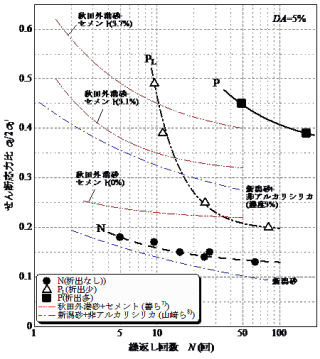 the amount of the mineral precipitated (at maximum threefold), 2) the augmentation
may be attributed mainly to improvement of deformation characteristics
due to intergranular cohesion evolved by the mineral precipitation, and
3) the liquefaction resistance can be evaluated via a simple relation between
normalized shear modulus and liquefaction resistance of bare sand.
the amount of the mineral precipitated (at maximum threefold), 2) the augmentation
may be attributed mainly to improvement of deformation characteristics
due to intergranular cohesion evolved by the mineral precipitation, and
3) the liquefaction resistance can be evaluated via a simple relation between
normalized shear modulus and liquefaction resistance of bare sand.
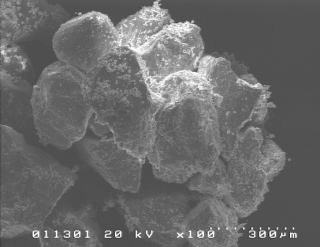
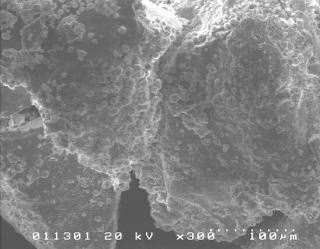
Mechanical properties improved with CaCO3 precipitation
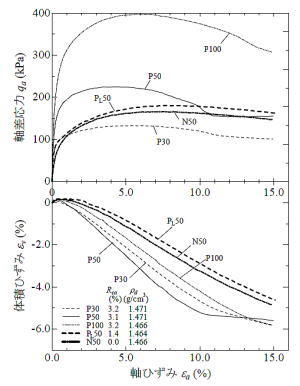 A series of drained triaxial tests was performed to look into the effects
of calcium carbonate precipitaiotn on mechanical properties of sand. SEM-EDX
was also utilized to examine the quality and quantity precipitated, revealing
that calcium carbonate is the only mineral precipitaed onto grain surface.
Well-controlled triaxial tes results show that calcium carbonate precipitated
within grain aggregate clearly augments Young’s modulus and shear strength,
and those magnitudes increase with the amount of the precipitated calcite.
This augmentation is attibuted to increase in surface roughness and of
positive dilatancy. The test results also demonstrate that intergrain adhesion
mediated by the precipitation exerts infuence significantly on the elastic
modulus, but little on the strength.
A series of drained triaxial tests was performed to look into the effects
of calcium carbonate precipitaiotn on mechanical properties of sand. SEM-EDX
was also utilized to examine the quality and quantity precipitated, revealing
that calcium carbonate is the only mineral precipitaed onto grain surface.
Well-controlled triaxial tes results show that calcium carbonate precipitated
within grain aggregate clearly augments Young’s modulus and shear strength,
and those magnitudes increase with the amount of the precipitated calcite.
This augmentation is attibuted to increase in surface roughness and of
positive dilatancy. The test results also demonstrate that intergrain adhesion
mediated by the precipitation exerts infuence significantly on the elastic
modulus, but little on the strength.
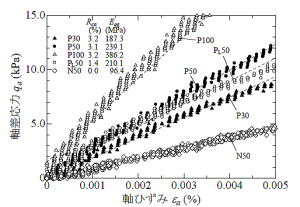

Effects of degree of saturation at CaCO3 precipitation
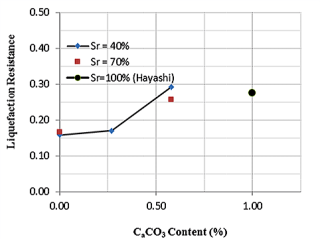 It has confirmed that this soil improving method significantly enhances not only the strength and stiffness of sand but the liquefaction resistance as well. The specimens were prepared at saturated condition and then calcite was precipitated in the specimens. Sand surface was observed with SEM and it was found that the precipitated calcite distributed more or less uniformly on the surface of grains and only a limited amount of calcite on the surface contributed to bond between particles. It clearly suggested that most portion of chemical regents injected into the sand were used to generate calcite on the grain surface which had nothing to do with mechanical properties in interest and only a limited amount of regents were used to bond between
It has confirmed that this soil improving method significantly enhances not only the strength and stiffness of sand but the liquefaction resistance as well. The specimens were prepared at saturated condition and then calcite was precipitated in the specimens. Sand surface was observed with SEM and it was found that the precipitated calcite distributed more or less uniformly on the surface of grains and only a limited amount of calcite on the surface contributed to bond between particles. It clearly suggested that most portion of chemical regents injected into the sand were used to generate calcite on the grain surface which had nothing to do with mechanical properties in interest and only a limited amount of regents were used to bond between 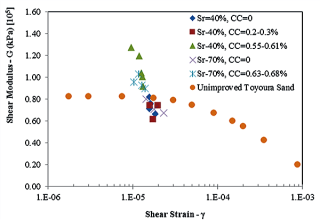 particles which directly contribute to improve the properties.
particles which directly contribute to improve the properties.
We have come up with an idea that calcite precipitation at lowered degree
of saturation may enhance efficiency of soil improvement, because in the
pendula saturation condition, pore water exists mostly at the contacts
between particles. Much smaller amount of calcite precipitation may be
enough to improve soil properties as compared to the previous studies.
In this study, degree of saturation during calcite precipitation on the
liquefaction strength of partially and fully saturated sand was investigated
through a series of triaxial test.
Two parameters selected as testing variables in this study are degree of saturation and calcite content. The main finding from the experiment are summarized as follows:
a. The existence of calcite content in sand sample enhance the liquefaction
resistance as well as shear modulus at small strain level. This is occurred
due to the restriction of buildup excess pore water pressure leading to
liquefaction.
b. Cyclic stress ratio grows up due to the compound of calcite content
and the decrease of saturation level in the sand sample. The bigger level
of calcite and the lower the degree of saturation in the sand samples bring
them stronger. This is probably due to the fact that precipitated calcite
tends to concentrate to the contact points between sand grains as degree
of saturation decreases. This hypothesis, however, have to be confirmed
by observing grain surface. Detailed observation with SEM will be reported
elsewhere in the near future.
Related publications
林和幸・安原英明・只信紗也佳・岡村未対(2010): 炭酸カルシウム結晶析出による砂の力学特性の改善効果,土木学会論文集C, Vol. 66,
No. 1, pp. 31-42.
林和幸・岡村未対・安原英明(2010):炭酸カルシウム結晶析出による砂の液状化特性の改善効果,地盤工学ジャーナル,Vol.5, No.2, pp.391-400.
小坂佳平,岡村未対(2015):炭酸カルシウム析出時の飽和度の違いが液状化強度特性に及ぼす影響,第50回地盤工学研究発表会
Yasuhara, H., Hayashi, K. and Okamura, M. (2011): Evolution in Mechanical and Hydraulic Properties of Calcite‐Cemented Sand Mediated by Biocatalyst , Proc. Geo‐Frontiers 2011: Advances in Geotechnical Engineering.
Minson Simatupang, Yoshihira Kosaka and Mitsu Okamura (2015): Effects of
defree of saturation on liquefaction resistance of sand improved with enzymatic
calcite precipitation, Pro. the 2nd Makassar International Conference on
Civil Engineering (MICCE 2015).
Minson, S., Okamura, M., H. Hayashi and H. Yasuhara (2018): Small-strain shear modulus and liquefaction resistance of sand with carbonate precipitation, International Journal of Soil Dynamics and Earthquake Engineering, Vol. 115, pp. 710-718, https://doi.org/10.1016/j.soildyn.2018.09.027
Minson Simatupang and Mitsu Okamura (2017): Liquefaction resistance of sand remediated with carbonate precipitation at different degrees of saturation during, Soils and foundations. Vol. 57, No. 4, pp. 619-631.